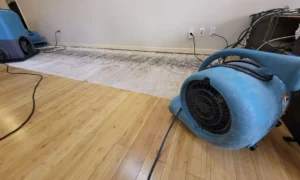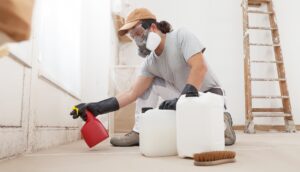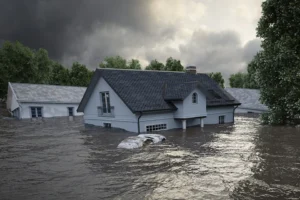Water damage in your home can be more than just a wet carpet or soggy walls. One of the biggest risks after a water incident is mold growth. Mold can start growing within 24 to 48 hours if the moisture isn’t dealt with properly. This not only weakens the structure of your home but also poses serious health risks, especially to those with allergies or respiratory issues.
Stopping mold before it starts is crucial to maintaining a healthy living space. Acting quickly after water damage can prevent mold spores from taking hold and spreading. Understanding why mold grows and knowing what steps to take immediately can make all the difference.
By learning and applying effective mold prevention strategies, you can protect your home and your family from the harmful effects of mold. In this article, we’ll dive into everything you need to know about preventing mold after water damage.
Understanding Why Mold Grows After Water Damage
Mold thrives in damp, dark environments, making water-damaged areas perfect for its growth. When your home experiences water damage, moisture seeps into materials like wood, drywall, and carpet. These materials can remain damp long after the water is gone, providing a breeding ground for mold spores.
Mold spores are everywhere and can begin to grow quickly when they find the right conditions. Warm temperatures and high humidity accelerate this process. Within just 24 to 48 hours, you might start seeing mold patches appear in damp areas.
Mold needs organic material to feed on, and your home’s building materials offer plenty of it. Once the spores land on these surfaces, they spread rapidly, causing unsightly stains and a musty odor. More importantly, mold can weaken structural materials over time and pose health risks, including respiratory issues and allergic reactions.
Immediate Steps to Prevent Mold Growth
Taking quick and effective steps after water damage can prevent mold from taking hold. Here are some essential actions to minimize mold growth:
1. Remove Standing Water: Use pumps, wet-dry vacuums, and mops to remove as much water as possible. Standing water is a direct invitation for mold to start growing.
2. Dry Affected Areas: Open windows and doors to promote air circulation. Use fans and dehumidifiers to speed up the drying process. Drying damp areas within 24 to 48 hours can prevent mold from forming.
3. Remove Damaged Materials: If possible, take out water-damaged items like carpets, rugs, and furniture. Mold can thrive in these materials, and removing them reduces mold risks.
4. Clean and Disinfect Surfaces: Use water and detergent to clean all surfaces that came in contact with water. Bathrooms, basements, and other damp areas should be scrubbed to remove any potential mold spores.
5. Monitor Humidity Levels: Keep an eye on your home’s humidity levels using a hygrometer. Ideally, indoor humidity should stay below 60%. If necessary, use dehumidifiers to maintain a dry environment.
Following these immediate steps can significantly reduce the likelihood of mold growing after water damage, ensuring your home stays safe and healthy.
Long-Term Mold Prevention Strategies
Maintaining a mold-free home requires ongoing effort. Here are some long-term strategies to prevent mold growth:
1. Control Humidity Levels: Consistently monitor and manage humidity in your home. Use dehumidifiers, especially in moisture-prone areas like basements and bathrooms. Aim to keep indoor humidity below 60%.
2. Improve Ventilation: Make sure your home has good airflow. Use exhaust fans in the kitchen and bathroom to remove moisture. Opening windows helps too, especially on dry days.
3. Fix Leaks Immediately: Attend to any plumbing leaks or roof issues as soon as they are noticed. Even small leaks can create damp conditions perfect for mold growth.
4. Insulate Pipes: Properly insulate pipes to prevent condensation. Insulated pipes are less likely to develop mold around them due to moisture build-up.
5. Regular Maintenance: Regularly check for signs of mold or moisture. Look behind appliances, under sinks, and around foundations. Address any issues immediately.
6. Use Mold-Resistant Products: When renovating or repairing your home, consider using mold-resistant drywall and paint. These products can help prevent mold growth and are a good investment for long-term prevention.
By applying these long-term strategies, you can keep your home mold-free and maintain a healthier environment.
Common Mistakes to Avoid After Water Damage
Avoiding common mistakes after water damage can save you from future mold problems. Here are some pitfalls to steer clear of:
1. Delaying Action: Waiting too long to address water damage allows mold to grow. Act within 24 to 48 hours to dry out affected areas.
2. Ignoring Small Leaks: Even small leaks can lead to serious mold problems over time. Don’t ignore them. Fix any leaks promptly to prevent moisture build-up.
3. Insufficient Drying: Simply mopping up visible water isn’t enough. Use dehumidifiers and fans to thoroughly dry all impacted areas, including hidden spaces.
4. Using the Wrong Cleaning Products: Not all cleaning products kill mold. Use disinfectants specifically designed to remove mold and mildew. Avoid using bleach, as it might not be effective on porous surfaces.
5. Overlooking HVAC Systems: Mold can grow inside HVAC systems and spread throughout your home. Regularly clean and maintain these systems to prevent mold growth.
6. Throwing Away Wet Materials Haphazardly: Mold can spread from wet items to your home. Properly dispose of any soaked materials like carpets, rugs, and insulation.
By avoiding these common mistakes, you can handle water damage more effectively and prevent mold from taking hold.
Safeguard Your Home from Mold After Water Damage
Preventing mold after water damage requires quick action and long-term diligence. Mold can start growing within a day or two, so it’s essential to act fast and follow the right steps. Understanding why mold grows and how to stop it before it spreads will keep your home safe and your family healthy.
By taking immediate steps like removing standing water and thoroughly drying affected areas, you minimize the risk of mold growth. Long-term strategies, such as controlling humidity and fixing leaks promptly, help maintain a mold-free environment. Avoiding common mistakes like ignoring small leaks or using ineffective cleaning products also plays a crucial role.
Keeping your home mold-free might seem like a lot of work, but it’s worth the effort. A clean, dry home improves indoor air quality and keeps your living space comfortable and safe. If you need professional water damage services, contact Northwest Restoration.
We’re here to help you protect your home from mold and keep it in top condition!









